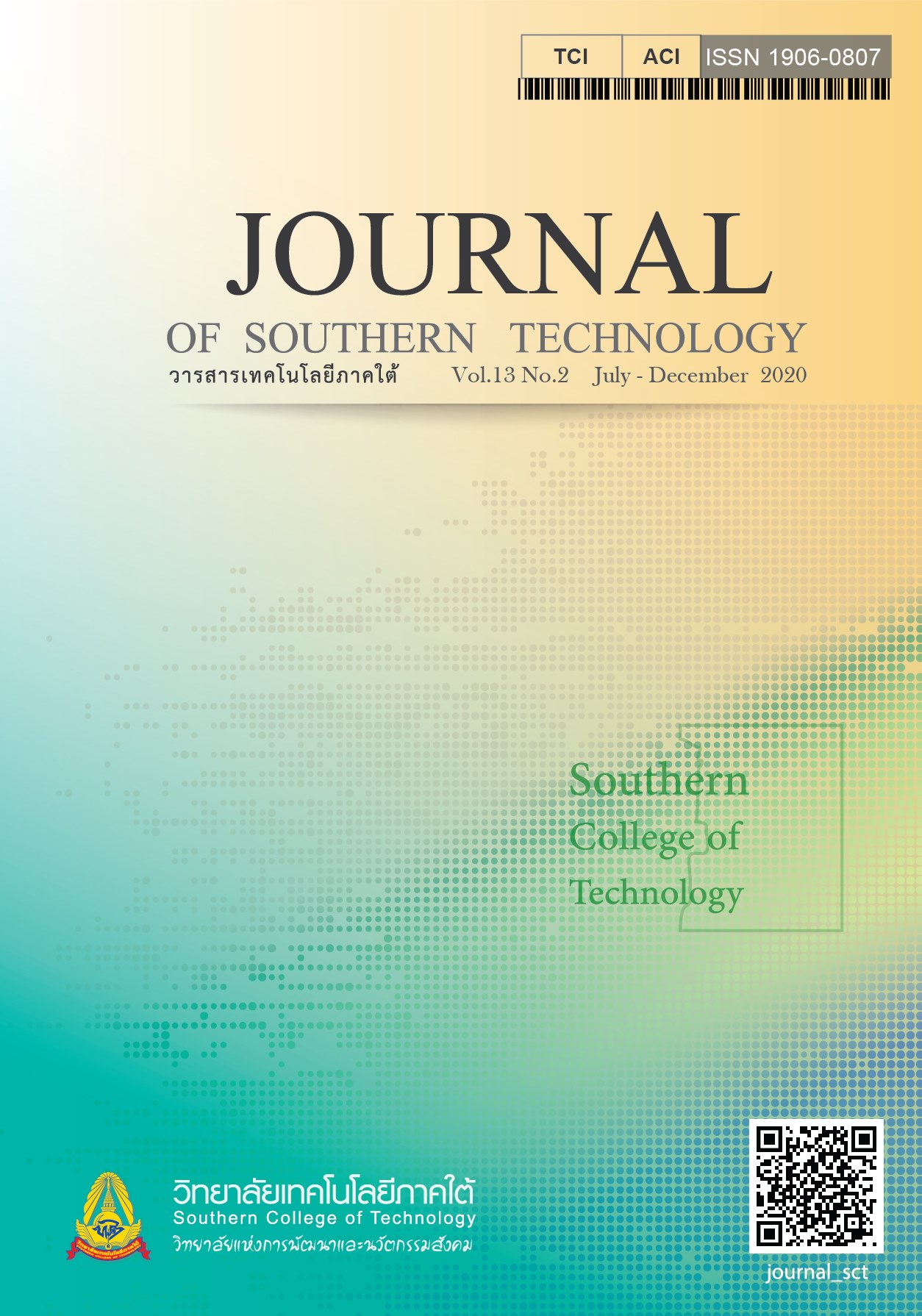Factors Affecting Elderly's Acceptance of Online Restaurants in Trang Province
Main Article Content
Abstract
This research aimed to study aging consumers’ acceptance of online restaurants and factors affecting their acceptance. Population and samples of this study were the elders aged 60 years old and above who live in Trang province with internet experience. This study adopted a Modified Unified Theory of Acceptance and Use Technology: (UTAUT2) model. Moreover, the study uses quantitative research methods. The samples were selected using convenience sampling consisted of 400 elders and the data were collected by questionnaire. Statistics employed for data analysis includes descriptive statistics; frequencies, percentage, mean, and analyze factors affecting elder acceptance on online restaurant by partial least square regression technique. This study found that aging consumers had a moderate acceptance of online restaurants (=3.36), with the interest to order food from an online restaurant at a high level (
=3.41). Also they tend to order food from an online restaurant on their own at a high level (
=3.45) and will continue to order food from an online restaurant at a moderate level (
=3.24). There are four factors that affect the elderly acceptance of an online restaurant which are habit, facilitating conditions, hedonic motivation, and social influence. Therefore, restaurant entrepreneurs can continue to develop their restaurant business online to meet the needs of older consumers.
Article Details
-
Authors must agree to the journal publication rules and allow the editors to edit the manuscripts for publication.
-
Author’s right belongs to the author but Journal of Southern Technology holds the right of first publication and thus allow readers to use the article for the purpose of education but not commercial.
References
Ajzen, I. (1991). The theory of planned behavior. Organizational Behavior and Human Decision Processes, 50(2), 179-211.
Akarachantachote, N., & Saithanu, K. (2017). Using partial least square regression in the case of violations of regression model assumptions. Huachiew Chalermprakiet Science and Technology Journal, 3(1), 69-75. [in Thai]
Arenas-Gaitán, J., Peral-Peral, B., & Ramón-Jerónimo, M. A. (2015). Elderly and internet banking: An application of UTAUT2. Journal of Internet Banking and Commerce, 20(1), 1-23.
Bujang, M. A., Sa' at, N., & Sidik, T.M.I.T.A.B. (2017). Determination of minimum sample size requirement for multiple linear regression and analysis of covariance based on experimental and non-experimental studies. Epidemiology, Biostatistics and Public Health, 14(3), 1-9.
Chaluay, P., Chaveesuk, S., & Pantuwong, N. (2015). Applying of the unified theory of acceptance and use of technology (UTAUT) and extending the unified theory of accep- tance and use of technology (UTAUT2) with e-business. KMITL Journal of Information Technology, 4(2), Unpaged. [in Thai]
Chiewpattanakul, A., Adisornprasert, W., & Yan- somboon, S. (2011). Factors affecting saving behavior and spending behavior of senior citizen. Journal of Humanities and Social Sciences, 3(6), 178-194. [in Thai]
Hair, J. F., Hult, G. M., Ringle, C. M., & Sarstedt, M. (2013). A Primer on Partial Least Squares Structural Equation Modeling (PLS-SEM). Thousand Oaks: SAGE Publications.
Hoque, R., & Sorwar, G. (2017). Understanding factors influencing the adoption of mHealth by the elderly: An extension of the UTAUT Model. International Journal of Medical Informatics, 101, 75-84.
In-klam, S. (2017). Nature of micro and small hotel and restaurant in Trang, Krabi and Phuket. Journal of Thai Hospitality & Tourism, 12(2), 17-27. [in Thai]
Kock, N. (2018). WarpPLS User Manual: Version 6.0. Laredo: TX: Script Warp Systems.
Macedo, I. M. (2017). Predicting the acceptance and use of information and communication technology by older adults: An empirical examination of the revised UTAUT2. Computers in Human Behavior, 75, 935-948.
National Statistical Office. (2018). The 2017 Food Consumption Behavior Survey. Retrieved October 31, 2018, from http://www.nso.go.th/sites/2014/DocLib13/ด้านสังคม/สาขาสุขภาพ/ Food_ consumption_ behavior_of_ the_ population/2560/รายงานฉบับสมบูรณ์.pdf. [in Thai]
Nunnally, J. C., & Benstein, I. H. (1994). Psycho- metric Theory (3rded.). McGraw-Hill.
Phuthong, T., & Mangsungnoen, N. (2017). Factors influencing the elderly intention to use and adopt mobile health services. Veridian E-Journal, Silpakorn University Humanities, Social Sciences and Arts, 10(3), 548-566. [in Thai]
Piriyakul, M. (2010). Partial least square path modeling (PLS path modeling). In the National Conference on Statistics and Applied Statistics, (pp. C1-C22). [in Thai]
Rouythanasombat, P. (2015). Study of Online Shopping Behavior and Factors Affecting Consumer’s Purchase Intention for Different Generations: Gen Y, Gen X, Baby Boomer (Master’s Independent Study). Thammasat University, Bangkok. [in Thai]
Sa-ard-dee, A. (2016). Attitude and Interest of the Elderly Towards Buying Dietary Supple- ment Product Via Mobile Application (Master’s Independent Study). Thammasat University, Bangkok. [in Thai]
Sanlaiad, K., Taweesuk, P., & Sakrungpongsakul, S. (2017). Technology acceptance affecting intention tendency on online shopping of baby boomers in Bangkok metropolitan. Panyapiwat Journal, 9(3), 3-15. [in Thai]
The Secretariat of the House of Representatives. (2016). Silver Economy. Retrieved June 5, 2017, from https://www.parliament.go.th/ewtcommittee/ewt/drive_econ/download/article/article_20160809081130.pdf. [in Thai]
Trang Province Statistical Office. (2017). The 2017 Establishment Survey on the Use of Information and Communication Technology. Retrieved October 31, 2018, from http://www.nso.go.th/sites/2014en/Pages/ Statistical%20Themes/ICT/The-2012-Estab lishment-Survey-On-Use-Of-Information-And-Communication Technology. aspx. [in Thai]
Venkatesh, V., Morris, M. G., Davis, G. B., & Davis, F. D. (2003). User acceptance of information technology: toward a unified view. MIS Quarterly, 27(3), 425-478.
Venkatesh, V., Thong, J., & Xu, X. (2012). Consumer acceptance and use of information technology: extending the unified theory of acceptance and use of technology. MIS Quarterly, 36(1), 157-178.

